Reserve Bank of Australia Annual Report – 2002 Financial System Stability
A resilient and efficient financial system linking the decisions of savers and investors is crucial for community confidence, macroeconomic stability and economic growth. For this reason, central banks have had a longstanding responsibility to safeguard the overall stability of the financial system. The RBA's mandate in this area is closely aligned with its other policy obligations, since low and stable inflation, a reliable payments system and well-functioning financial markets are essential foundations for financial stability.
A low-inflation environment, however, does not guarantee financial stability. Over the past decade, inflation has been successfully reined in by industrial countries yet episodes of financial instability have persisted. Hence, the RBA also attaches high priority to monitoring the health of the Australian financial system and identifying potential vulnerabilities. To assist in this task, it has drawn on earlier episodes of financial instability in Australia and overseas to develop a range of ‘macroprudential’ or financial stability indicators. It has analysed, in each episode, what made the financial system vulnerable to a particular disturbance; what event or factor triggered the bout of instability; how the disturbance was transmitted through the financial system; and the macroeconomic costs involved. Experience confirms the risks to financial stability posed, in particular, by rapid growth in credit fuelling asset price inflation. The RBA's focus on macroprudential indicators, which are constructed from aggregate financial and economic data, complements the role of the Australian Prudential Regulation Authority (APRA) in monitoring the financial condition and risk management processes of individual financial institutions, and the RBA and APRA work closely together through various formal and informal co-ordination mechanisms.
From a financial stability perspective, the past year was a challenging one for policy-makers. A series of unprecedented shocks to the global financial system, beginning with the September 11 terrorist attacks in the United States, hit an already fragile world economy. It is a testimony to the resilience of international financial markets and banking systems, and to the efforts that have been made to strengthen the international financial architecture, that the systemic consequences of these various shocks were relatively muted. Nonetheless, this positive outcome was far from certain as the consequences of each shock unfolded, and there are some important lessons to be learnt. As it had in the earlier Asian crisis, the Australian financial system has weathered the difficult external environment and in the RBA's assessment is in strong overall condition, underpinned by and in turn contributing to the sustained growth of the Australian economy. The general insurance sector, however, remains under some pressure.
The Stability of the Australian Financial System
The International Environment
Over the first half of 2001/02, global economic conditions were at their weakest for a decade. The downturn in economic growth, which had begun earlier in the United States in the wake of the collapse of the ‘high tech’ bubble, spread to all major regions. Weaker economic conditions in the United States were quickly reflected in a deterioration in credit quality in that country, particularly for business lending: business loan delinquencies climbed to their highest level since 1993, corporate bond default rates rose to record levels and the number of bankruptcy filings increased sharply.
The global economy was then confronted by three severe financial shocks, in rapid succession: the September 11 terrorist attacks, the collapse of the major US energy company, Enron, and the largest ever sovereign debt default (Argentina). The terrorist attacks had an immediate effect on consumer and business confidence in the United States and elsewhere, with share prices falling sharply and credit spreads widening. Though these financial market impacts proved relatively short-lived, the cumulative effect of the three financial shocks, and other large corporate collapses in the United States, reinforced the widespread pessimism about global economic prospects as 2001 ended.
This pessimism waned during the second half of 2001/02, with the global economy appearing to have turned the corner and a modest recovery getting under way in most major economies. While recovery has been led by the United States, uncertainty remains about its strength and durability because of continuing doubts about the underlying profitability of the business sector. These doubts, and a recognition that share price valuations in the United States are still quite high by historical standards, have weighed on investor confidence over recent months. As a result, share markets in the US and other major economies have come under renewed pressure.

Some very tentative signs of a Japanese recovery have also begun to emerge. In 2001, Japan lapsed back into recession, its third and most severe in a decade. Beset by the legacy of substantial non-performing loans in its banking sector, Japan was seen as increasingly vulnerable to a collapse in investor confidence, particularly with the planned removal of the blanket guarantee on term deposits at banks on 1 April 2002. In the event, this change was achieved with minimal disruption. Australia has important financial linkages to Japan but these have diminished in scale over the past decade and have been largely decoupled from the trade linkages between the two countries. The claims of Australian banks on Japanese borrowers have fallen from the equivalent of around eight per cent of Australia's GDP in 1991 to one per cent now, pushing Japan from second to sixth position in the ranking of countries to which Australian banks are most exposed. Japan, in turn, is a major creditor nation that has invested heavily in Australia in the past; however, the claims of Japanese banks on Australian borrowers have also fallen substantially, from the equivalent of around 12 per cent of Australian GDP in 1991 to four per cent.

Domestic Developments
Despite the difficult external environment, the Australian financial system continued to perform well in 2001/02, supported by high levels of consumer confidence and the strength of the Australian economy. A feature of domestic developments was the resumption of rapid growth in credit extended by Australian financial institutions to the household sector, after an easing in growth the previous year. Growth in credit to business, however, was at its lowest for some years and growth in total credit, at around 10 per cent, was a little below its recent average. Divergent trends in credit growth over recent years have meant that, for the first time in half a century at least, the household sector now has a higher level of debt than the business sector.

The continued willingness of Australian households to incur debt is a natural consequence of the adjustment to a low-inflation (and hence low-interest rate) environment, and improved access to credit arising from financial deregulation. The increase in household indebtedness has been accompanied by a substantial increase in household wealth. After rising strongly over the past decade, the gearing of household balance sheets is now much in line with other developed countries. Despite the increase in debt levels, the interest burden on households is well below previous peaks, as interest rates remain near historically low levels. Nonetheless, any continuation of the recent pace of borrowings, which has been accompanied by a significant increase in the average size of loans, would leave households increasingly vulnerable to adverse economic developments.
Borrowing for housing has been the main impetus behind the recent increases in household indebtedness; a decade ago, such borrowing accounted for 70 per cent of total household debt but it now accounts for 85 per cent. This surge in borrowing has been associated with a sustained rise in residential property prices. The cumulative rise in real terms over the past few years is comparable to that of the late 1980s, although the rises recorded then occurred over a shorter period and were more concentrated geographically. Rising residential property prices have been an important contributor to increased household wealth and consumer confidence; however, if property prices overshoot their fundamental levels, any substantial correction could put pressure on household finances, particularly for heavily geared borrowers who entered the property market in the latter part of the upswing. In the case of owner-occupied housing debt, the equity which most borrowers have built up in their properties acts as a buffer against such pressures. One noteworthy feature of recent trends, however, is the growth in household borrowings for investment properties, which accounted for more than half of the pick-up in new housing approvals over the past 18 months. At this point in time, the investment property market faces low rental yields and rising rental vacancy rates, with additional supply in the offing; such a market may prove a disappointment to borrowers who have entered recently in pursuit of capital gains.
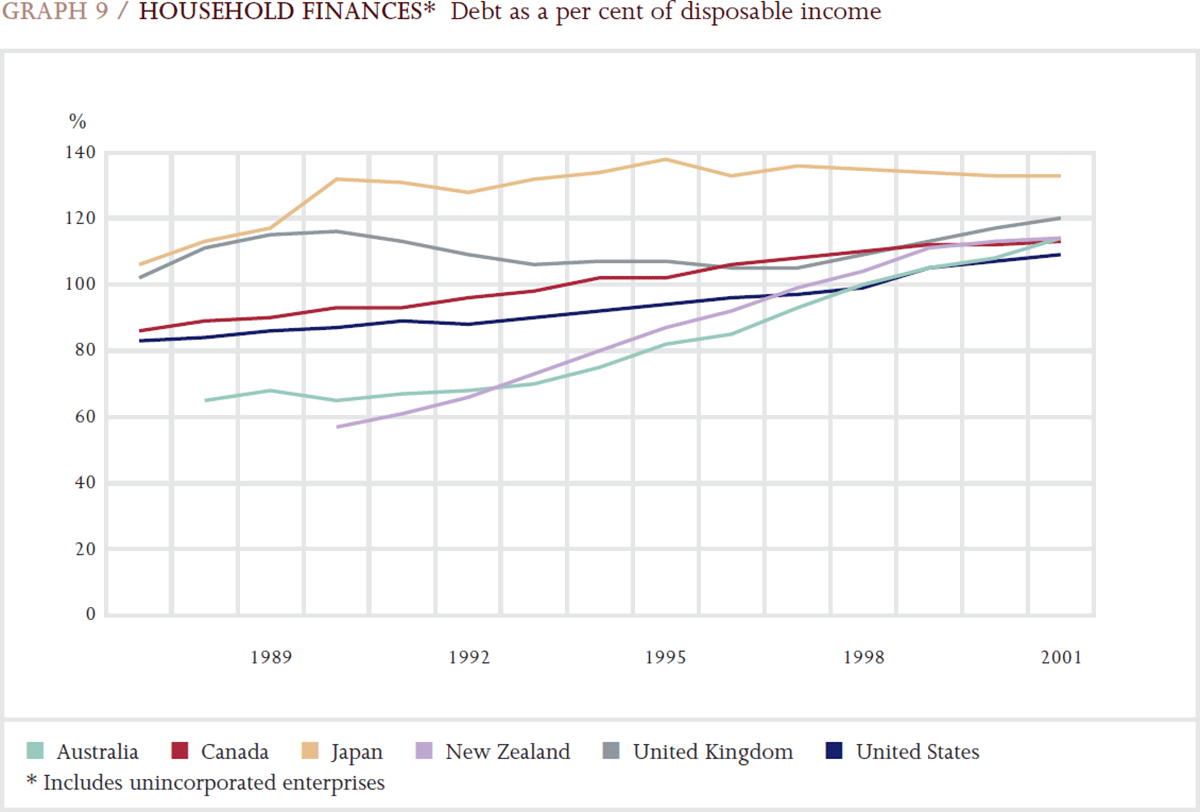
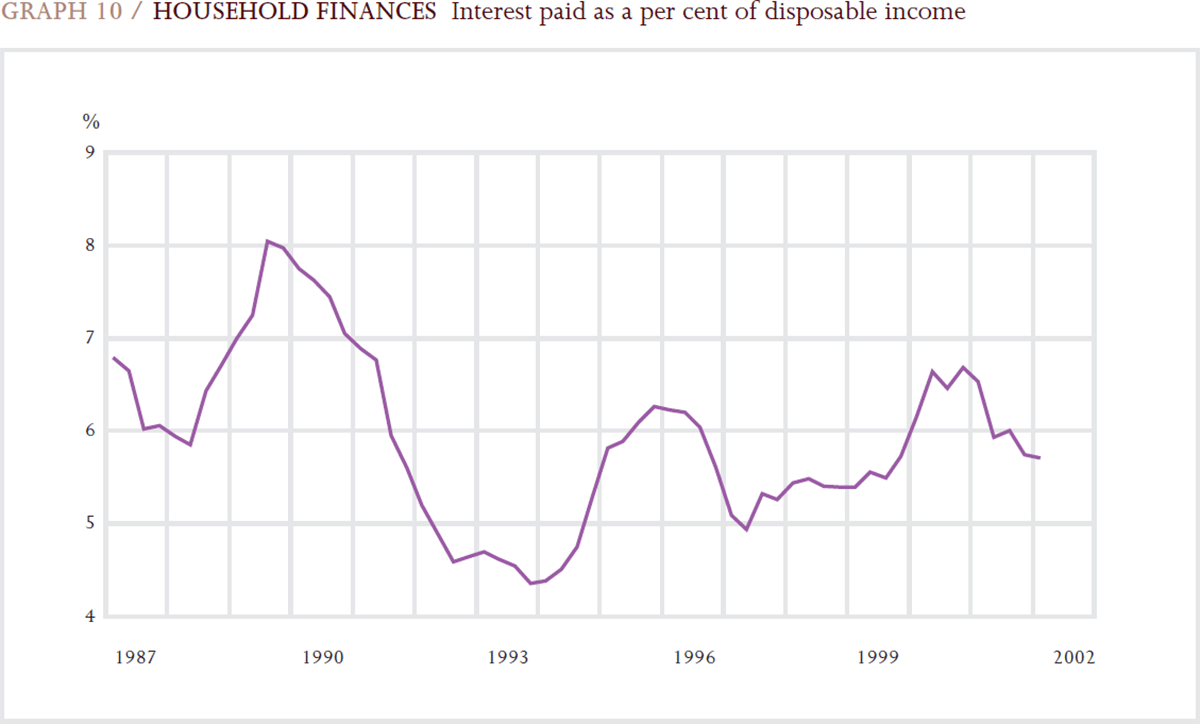
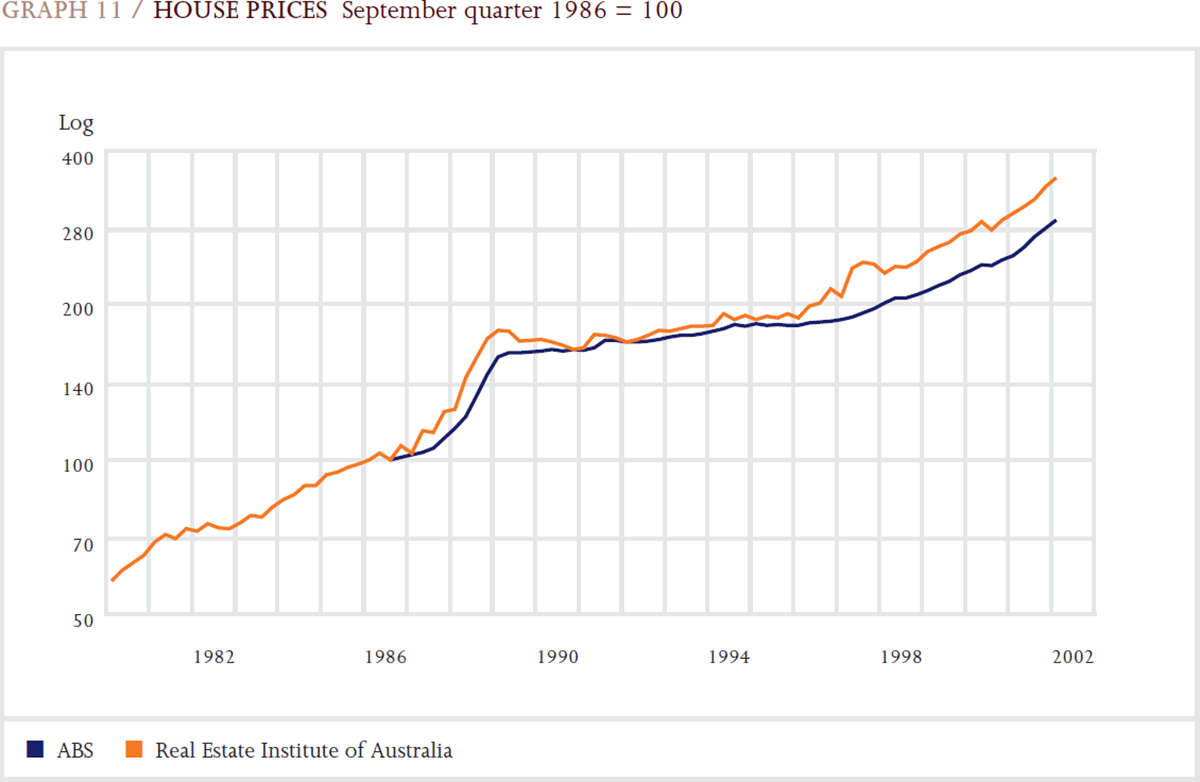
Another component of credit to households which continues to increase strongly, albeit from a low base, is margin lending. Such lending, which allows households to purchase shares and other financial assets using these purchases as collateral, is more risky than other forms of lending and is closely monitored by the RBA. The average loan-to-valuation ratio was around 45 per cent at year-end, its lowest level since the RBA began surveying margin lenders in September 2000 and well below the maximum ratio of 70 per cent that banks are prepared to extend for ‘blue chip’ shares.
Despite a number of high-profile corporate collapses during 2001/02, the financial position of the business sector remains sound. Improving profitability and generally positive share market sentiment have enabled businesses to rely on accumulated internal funds and equity raisings for their funding. Businesses had only limited additional recourse to the banking system for much of the year, though demand for business credit has picked up recently. As a consequence, the debt-to-equity ratio of the business sector is well below its late 1980s peak and its interest burden is at historically low levels. Market indicators also convey a favourable assessment of the riskiness of the business sector generally. Credit spreads for low- and high-grade corporate debt are on average below their levels of the previous year, and are narrower than comparable spreads in the United States.
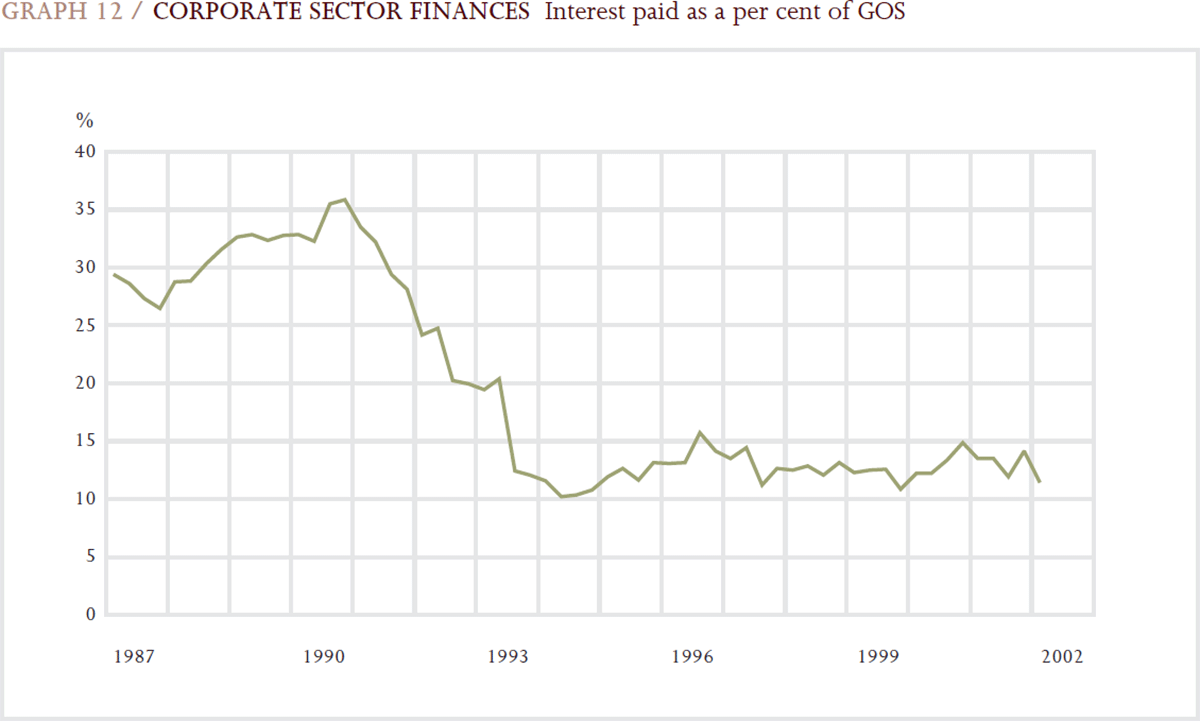
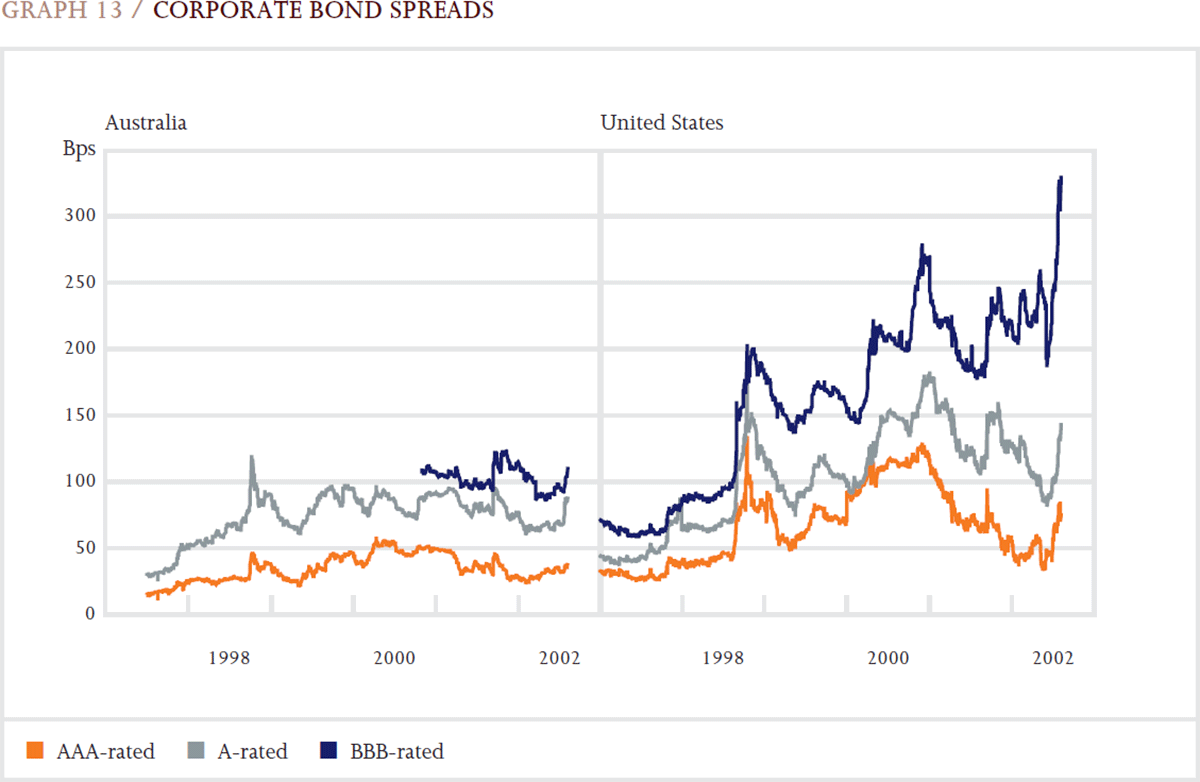
Australia's sustained economic expansion has continued to underpin the strength of authorised deposit-taking institutions. Notwithstanding recent corporate collapses, asset quality overall has remained robust. For banks, the ratio of impaired assets to total assets was 0.6 per cent at year-end, close to its minimum point over the past decade and only one-tenth its peak in the early 1990s. For building societies and credit unions, impaired asset ratios are at cyclical lows. Problem loans do not appear to be concentrated in particular sectors of the economy.
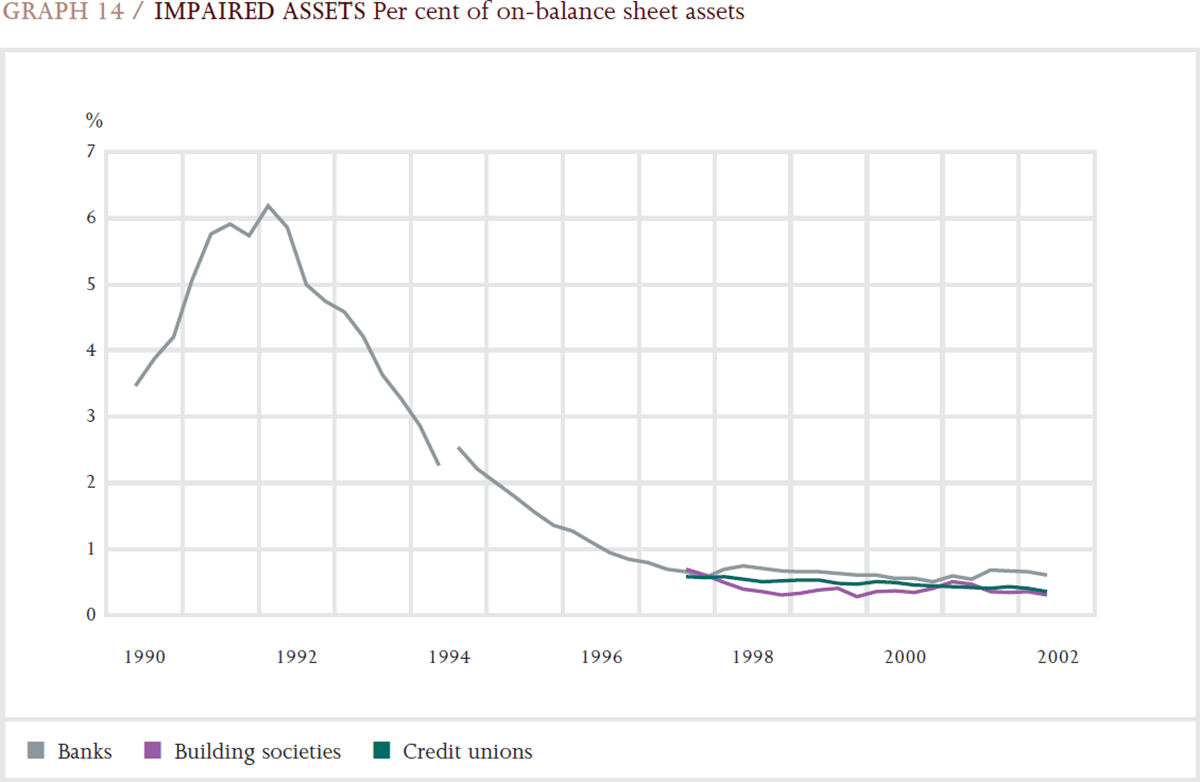
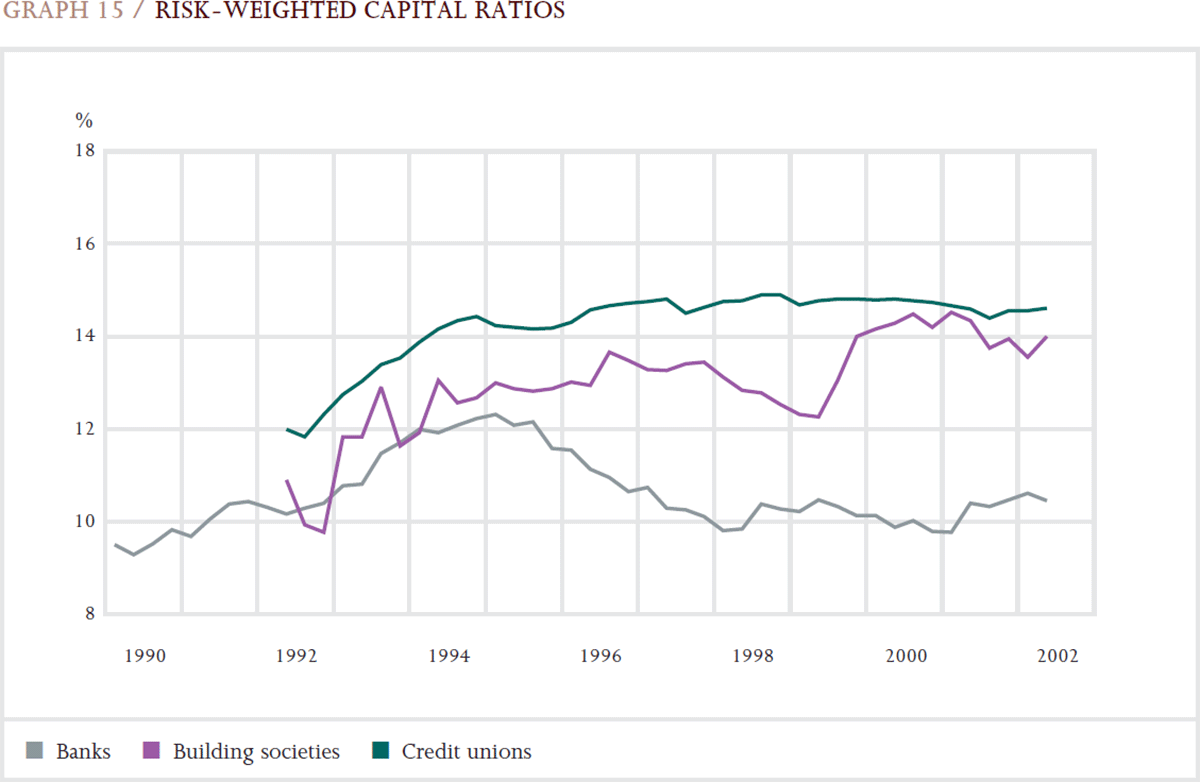
The growing share of household lending in their balance sheets has, in the main, reduced the risk profile of deposit-taking institutions, although lending portfolios are now more sensitive to the health of household finances and to residential property prices. That said, these institutions appear well-positioned to cope if there were to be any substantial correction in property prices, particularly investment properties. Where housing loans are provided with a loan-to-valuation ratio greater than 80 per cent, these must be fully covered by mortgage insurance provided through an acceptable insurer, with at least an A-rating, if such lending is to attract the concessional risk-weight under APRA's prudential framework. Hence, the risk of loss on such loans is shifted from deposit-taking institutions to insurance companies. Deposit-taking institutions also remain well-capitalised. The aggregate risk-weighted capital ratio for banks rose a little to 10.5 per cent by year-end while capital ratios for building societies and credit unions were around 14 per cent; for each of these groups, capital ratios are well above minimum required levels. The profitability of deposit-taking institutions is high and market indicators continue to signal confidence in the credit quality of Australian banks. Credit spreads on AA-rated bonds issued by Australian banks have declined to around 40 basis points, close to their lowest level in four years and well below credit spreads on equivalent US bank bonds.
Deposit-taking institutions placed greater reliance on domestic deposits, particularly from the household sector, to fund their asset growth over the past year. This represents a marked departure from recent trends, when borrowings in offshore wholesale markets increased significantly at the expense of domestic funding sources. The share of Australia's gross foreign debt accounted for by financial institutions (mostly banks) on a hedged basis has steadied at around 65 per cent over the past year, compared with a share of 32 per cent a decade earlier.
The general insurance industry remains the exception to the generally positive assessment of the Australian financial system. Following the collapse of HIH Insurance Limited in March 2001 and the earlier failure of some specialist reinsurance companies, the industry faced the catastrophe of the September 11 terrorist attacks and the natural disaster of the Christmas 2001 bushfires in New South Wales. The terrorist attacks led to the largest ever claims on the international insurance chain (with estimates of losses still rising) and cast doubts over the solvency of segments of the global insurance industry. Indications are that the direct exposure of Australian insurers to claims arising out of the terrorist attacks is relatively small, although a more lasting impact is likely to be an increase in global reinsurance premiums and the withdrawal of terrorist cover by reinsurers.
Stresses in the general insurance sector have recently manifested themselves in rising premiums and the reduced provision of specific lines of insurance, such as builders' warranty, public liability and medical indemnity insurance. A number of insurers have exited these lines of business because of financial problems or because these lines were deemed increasingly unprofitable on a reassessment of risk. Higher premiums and reduced access to certain forms of insurance have meant that some businesses and individuals have been unable to obtain adequate insurance cover and have been forced to cease operations or reduce the amount of production. Government assistance has been sought to fill the shortfall in cover and calls for changes to legislation (such as that relating to the allocation of damages in public liability cases) have been made. Against the background of these difficulties, APRA's reform of the regulatory framework for general insurance, which came into force on 1 July 2002, could not have been more timely. New prudential standards, which require general insurers to maintain higher levels of capital and have in place rigorous systems for managing insurance risks, are aimed at improving governance in this industry and reducing the likelihood of failures.
Lessons for Financial Stability
The severe shocks which buffeted the global financial system in 2001/02 have provided some important lessons for policy-makers.
The terrorist attacks of September 11 sharply increased the risks to global financial stability, not only in the United States but around the world. Reflecting the importance of New York to global trading activity, the attacks themselves disrupted the normal operation of financial markets and the trading capacity of global financial institutions. The key priority for central banks was to ensure that financial systems remained functional and that the uncertainty and risk aversion that immediately engulfed markets did not lead to a breakdown in payment and settlement arrangements. The steps taken by the RBA to this end are described in the chapter on ‘Operations in Financial Markets’. The RBA also liaised closely with APRA through this period.
From a financial stability perspective, the terrorist attacks have emphasised the importance of well-developed disaster recovery plans within the financial sector. Fortuitously, preparation for the Y2K problem had already raised awareness of contingency planning among financial institutions. Central banks and financial regulators are now reviewing potential vulnerabilities that may arise from factors such as the concentration of clearing and settlement systems, the loss of key personnel and the location of back-up facilities.
In December, the US energy company Enron filed for Chapter 11 bankruptcy protection, the largest such filing in US history at that point. Enron's collapse threatened to disrupt financial stability through the impact on its creditors or the unwinding of its large positions in financial markets. These fears have not been realised, mainly because exposures to Enron appear to have been widely dispersed. A number of Australian banks announced exposures to Enron but these were small relative to the size of their overall loan portfolios.
The dispersion of exposures to Enron highlights the advances made by financial markets over recent years in developing new financial instruments that allow for the separation and reallocation of risks. The rapid growth of credit derivatives, for example, has facilitated the packaging of credit risk in a form that can be sold by banks providing the credit (the ‘originating’ banks) to a wide investor base, including managed funds and insurance companies. By reducing the concentration of risk associated with the failure of any company, the trading of such financial instruments may be supportive of financial stability. This would not be so, however, if the instruments simply transferred credit risk to a class of investor that is less familiar with such risk and is poorly placed to manage and absorb it. The challenge for policy-makers is to understand the implications for longer run stability of moving towards a financial system in which the traditional ‘originate and hold’ approach to credit risk by banks is replaced by one which emphasises ‘origination and distribution’ of risk. The RBA has been working on this issue with other central banks, under the auspices of the BIS.
One concomitant of the growing trading in risk – whether for traditional financial products such as loans or for non-financial contracts such as energy contracts – is the increasing difficulty faced by investors in understanding the financial position of complex companies, a problem writ large in the case of Enron. More generally, investors have become much more sceptical about accounting and corporate governance practices within the corporate sector, in the United States and elsewhere, and are now punishing companies that resort to opaque or aggressive accounting practices. Some recent corporate failures in Australia have fuelled similar concerns though not to the same extent. Internationally, and at home, attention is turning to measures that will enhance accounting standards, the timeliness of financial disclosure by companies and standards of corporate governance.
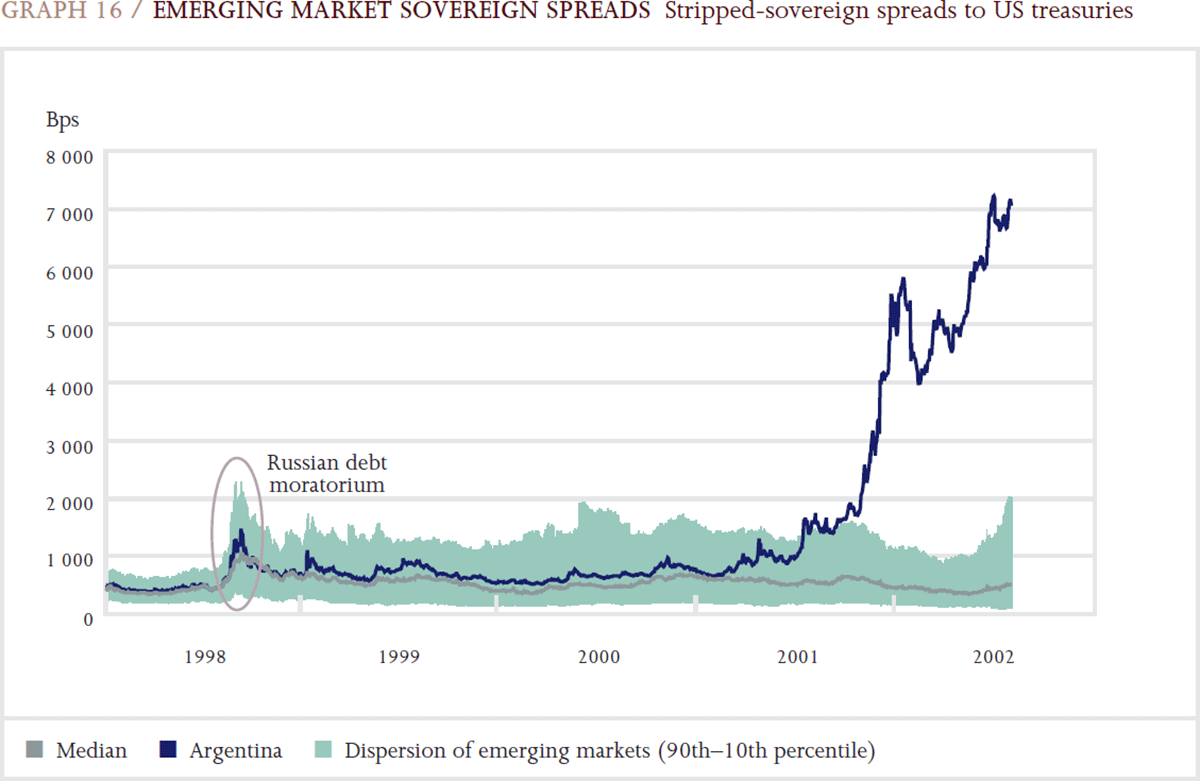
The collapse of Enron was followed closely, in late December, by the largest ever sovereign debt default when, after continuing economic and political turmoil, the government of Argentina defaulted on its debt and abandoned its decade-long currency board arrangements. Australia has very limited direct financial and trade linkages with Argentina and the Argentine crisis has had minimal impact on the Australian financial system. Initially, there was only limited contagion from Argentina to other emerging-market economies, although investors have recently become more concerned about some neighbouring Latin American countries, particularly Uruguay and Brazil.
Payments System Developments
The Payments System Board of the RBA has a mandate to promote the safety and efficiency of the payments system in Australia, with the backing of comprehensive powers. That mandate was expanded, in September 2001, when the Board was also given responsibility for the safety of facilities that clear and settle securities transactions in Australia's wholesale financial markets.
The RBA formally exercised its payments system powers for the first time in April 2001, when it brought the credit card schemes operated in Australia by Bankcard, MasterCard and Visa under its regulatory oversight. In December 2001, after detailed discussions with a wide range of interested parties, the RBA released a Consultation Document, Reform of Credit Card Schemes in Australia, which proposed a series of measures designed to promote greater efficiency, transparency and competition in the Australian payments system. Underlying these proposed reforms, which are now being finalised, is the RBA's judgment that the restrictions that are imposed by credit card schemes and their members are not in the public interest and result in the community paying a higher cost for its retail payments system than is necessary.
The RBA is also working with industry participants on reform of interchange fee arrangements in debit card and ATM networks. Changes in these areas, particularly if they can be co-ordinated with reform of credit card schemes, will help to ensure that the price signals in card payment networks in Australia promote well-informed consumer choice and efficient resource allocation.
In the safety and stability area, the RBA strongly supports the inclusion of the Australian dollar in the ‘continuous linked settlement’ or CLS Bank, a special-purpose bank which will handle the settlement of foreign exchange transactions in major currencies, including the Australian dollar. This initiative will substantially reduce foreign exchange settlement risks for participants. As described elsewhere in this Report, the RBA has continued to work closely with CLS Bank, the four major banks which are its Australian members, and other participants in the foreign exchange market to ensure its smooth introduction, now expected in the second half of 2002.
The broadening of the Payments System Board's mandate to encompass clearing and settlement facilities for securities and derivatives was confirmed with the passage of the Financial Services Reform Act 2001 in September 2001. Under a functional allocation of responsibilities, the RBA is charged with ensuring that clearing and settlement facilities conduct their affairs in a way that is consistent with financial system stability. As part of this role, the RBA has the power to set and monitor compliance with financial stability standards for clearing and settlement systems. ASIC has responsibility for all other matters, such as those relating to corporate governance, market integrity and investor protection, as well as undertaking any legal action to enforce compliance with the requirements of either agency, including financial stability standards. The RBA and ASIC have published a Memorandum of Understanding as a basis for co-ordinating their roles. The RBA's financial stability standards will shortly be released in draft form for public comment.
Further information on payment system issues can be found in the Annual Reports of the Payments System Board.